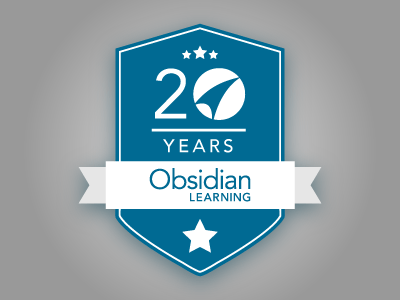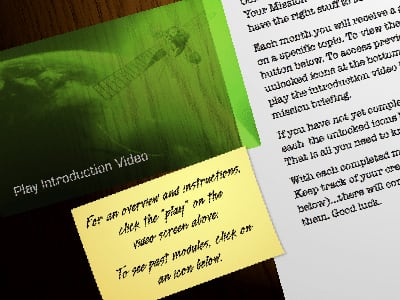– Mark Twain
Perhaps because I’m a dog-lover (and a decent fan of Mark Twain), this quote had always resonated with me. And – despite the incongruity – it’s a really great baseline for the subject of microlearning. I know, I know…hasn’t it all been said? Aren’t microlearning strategies firmly established in the learning toolkit? They are indeed…and yet, we at Obsidian Learning believe that our unique conceptual approach to microlearning brings some added value to how microlearning is viewed and –more importantly – how it is applied – as part of a larger learning strategy.
In this series we will:
- Go beyond the definition of microlearning by focusing on its effective application in the realm of employee education and development.
- Explore the different kinds of microlearning and go in greater detail than “a short online learning module” by presenting and describing specific solutions and their associated learning context.
- Highlight the importance of microlearning in the ecosystem of learning assets by illustrating how ideal learning design always integrates fit-for-purpose microlearnings.
And we will never lose sight of the most important aspect of microlearning (well, any learning): the learner.
And now back to the dogs (you were waiting for that, right?). As with those vicious fighters, size may matter, but it’s only one element among many. I have seen elaborate, beautifully graphically designed courses that just did not deliver the necessary punch (that is, they did not fulfill the learning need). And on the other hand I’ve also seen posters, quick animations, and impactful quotes that brought home the intended message with simplicity and elegance. Let’s see how it’s done.
What is microlearning?
Let’s start, well, at the beginning. At the risk of sounding basic: the Wikipedia definition of microlearning. But we’re going to spice it up a little. In the following table, you’ll see elements of the Wiki definition, accompanied by Obsidian Learning’s breakdown.
| Wiki | Obsidian's Take |
|---|---|
| Microlearning deals with relatively small learning units and short-term learning activities. The term is used in eLearning and related fields in the sense of learning processes in mediated environments. | Though most contemporary microlearnings are in digital form, there is more than enough evidence from our experience that microlearnings come in all different shapes... and small sizes. |
| Microlearning is a holistic approach for skill-based learning and education which deals with relatively small learning units. It involves short-term, focused strategies especially designed for skill-based understanding/learning/education. | We have successfully applied this concept not only to skill-based understanding and learning, but also to variety of subjects. From soft skills to highly technical content, microlearnings bring value to the learning. |
| Microlearning refers to “micro” perspectives of learning, education, training and skill development. This learning technique is versatile not only for skill-based education but also for sustainable socioeconomic development. Furthermore, microlearning marks a transition from common models of learning towards micro perspectives on and the significance of micro dimensions in the process of learning. The microlearning approach is an emergent paradigm, so there are no hard definitions or coherent uses of the term yet. | We agree that the definition is amorphous. The concept continues to evolve, and there are no set applications. And that’s just fine. From our experience, both the concept and its execution are directly influenced by new, cheaper, and more accessible technologies which are also constantly changing. |
| However, the growing focus on microlearning activities can be seen by web users’ activities on the subject, who tag their corresponding weblog postings and social bookmarks with the term “microlearning.” | Yep. Microlearning is trendy. But for a really good reason: done properly, it works. |
What does microlearning look like?
Let’s get practical. If you see a piece of learning content, how do you know it’s microlearning…or not? There are several considerations:
The scope of information.
Let’s say your employees watch this one-minute clip on safety. Is it microlearning or not? It is indeed, because it provides coherent and, in this case, actionable information “nuggets” that can be remembered and put into practice during employees’ daily activities. Contrast is used to illustrate the key points, allows the information to be packaged into much smaller units, called microcontent. These small chunks of information can stand alone or be used in a variety of contexts, and are great candidates for microlearning.

Point of need.
Microlearnings are a great way move to away from the lifeless, dreaded online course. In our experience, one of the most effective uses of microlearning is performance support. Now, as I work in learning and development, the type of performance support that I need is often a refresher. If a project has me stumped, it’s easy for me to get lost in the rabbit hole of learning theory. ADDIE is a tried-and-true learning model, so a device along the lines of this ADDIE infographic can help get me unstuck. It reminds me of some important basic principles and can help get my brain moving again. Now, there is a lot of information out there about ADDIE – books, research papers, entire websites. All of that can contain useful, relevant information. But is it really what I need when I’m in the middle of a project? Probably not. Microcontent targets a specific need at a specific time, and does it by encapsulating the necessary information in an easily digestible, easily accessible format. What I need, when I need it!

You can build on it.
In the corporate learning space a 45-60 minute long, text-heavy webbased training is fairly commonplace. That type of learning has its place, but it’s unrealistic to expect learners to immediately start applying the 60 minutes’ worth of information they’ve just been exposed to. It’s also somewhat unlikely that they’re going to log in and parse through the entire course to find that little bit of information that’s going to help them solve a specific problem. What’s the alternative? Again, microlearning to the rescue! Imagine a learning program that covers the exact same 60 minutes’ worth of information, but instead of a single module, the information is strategically segmented into stand-alone, coherent chunks which can build on one other, and are easily accessible not only during the training but – more importantly – at the time of need. In our experience, this strategic, comprehensive approach to microlearning is a one of the most impactful tools in our design toolkit for learning, teaching, behavior change, and performance improvement.
Case Study
To illustrate these critical points, let’s look at a specific example.
In 2014, a small oil and gas service company tasked us with a pretty challenging mission. The company had started growing a little too fast, and while the growth was indeed supported by the demand for their services, company leadership identified a serious and pressing need for training of new hires. They were taking on up to 12 new employees per week – and they needed them in the field ASAP. The added complication was that the equipment they were being hired to operate could malfunction if manipulated incorrectly, potentially putting the lives of these new hires and their colleagues at risk.
Yes, there was a manual. Yes, there was a compulsory online safety course. Leadership was firmly convinced that more training was necessary. These people really cared. Not only about the bottom line, but also about the safety and security of their employees. Plus, they clearly understood that if they invested in their personnel, both the safety issue and the bottom line would be likely to improve.
They hired Obsidian Learning to create “something useful.” That was literally their highest priority requirement. After our review of the existing materials, speaking to new hires and experienced SMEs, learning more about the equipment and safety measures, we designed a video-based digital learning piece which served two purposes:
-
A solid overview of the machinery and its inspection, operation, and maintenance with safety information intertwined within the context of the different tasks. In other words, it would work as classic online training.
-
A quick reference in case of need in the field. In other words, it would also work as performance support.

Our final deliverable achieved both of those aims, and is considered something of a benchmark here at Obsidian Learning. You can see a short sample of it here.
The combination of video, contextual animation, and structuring the content into short but coherent bursts of information was highly successful. In terms of employee engagement, time to competency, and improved safety and security, the before (manual, online training course) paled in comparison with the after (comprehensive microlearning-based program).
This project was a kind of “proof of concept” for the team at Obsidian Learning. We saw firsthand how microlearning could be an excellent vehicle for performance support, and also how individual microlearnings strung together can combine to create a comprehensive learning program. We saw it, we believe it, we apply it.







